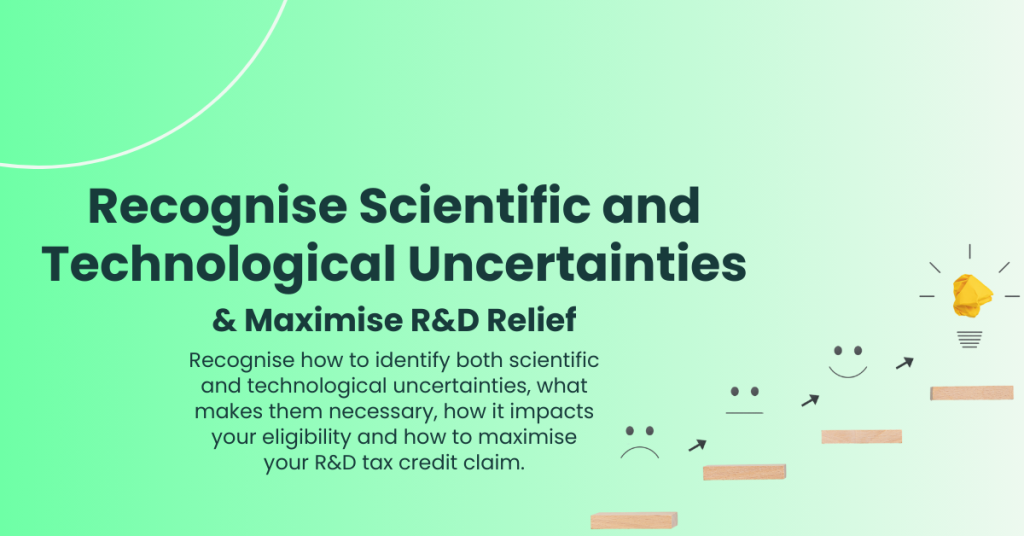Recognise Technological Uncertainties & Maximise R&D Relief

It’s one of the most important parts of an R&D claim – decipher the ins and outs of technological uncertainties. Recognise how to identify scientific and technological uncertainties, what makes them necessary, how it impacts your eligibility and how to maximise your R&D tax credit claim.
In the world of R&D tax credits, being able to identify and present your technological uncertainty is essential. As the very basis of the relief, these uncertainties act as the initial qualifying criteria that will ultimately determine the success of a claim. But how can understanding it help you to maximise a claim?
Well we answer this important question and more, with this deep dive into technological uncertainties – what they are, how to navigate them, and how they act as the primary guideline for all R&D claims.
What is a Technological Uncertainty?
The concept of technological uncertainties may be vast, but in its definition they can be stringent. You see, a technological uncertainty arises when there is no clear path or solution to achieve a specific outcome in a project.
This represents a gap in knowledge or capability that must be addressed through innovative thinking and experimentation.
How to Identify Technological Uncertainties
In relation to R&D tax relief, HMRC has an even clearer definition in regards to technological uncertainties, wherein there is no clear path or solution that can be overcome by an expert individual in the field.
Essentially this means that in relation to R&D tax credits, a team is required to push the boundaries of existing knowledge in order to achieve the specified outcome – making identifying the technological uncertainties a necessity in order to identify where further investigation and research are required. By recognising and addressing these uncertainties, businesses can push the boundaries of knowledge and create groundbreaking solutions.
The following showcases how you may identify whether or not your research and development project meets the definition of a technological uncertainty, and therefore qualifies for R&D tax credits:
- Verify that the project is focused on scientific or technological advancement
- Evaluate existing solutions and knowledge
- Determine whether a competent professional could individually provide a solution
- Verify that research and development is necessary to overcoming establishing a solution
- Confirm that the solution is technological based and not commercial
While these steps will help you to identify your technological uncertainties, speaking to a professional R&D tax credit specialist will help you to quickly confirm whether or not your project falls within the parameters of HMRC’s definition.
Book a quick call back
By undergoing a research and development project with the aim of resolving a technological uncertainty, businesses are able to:
- Explore new solutions
- Experiment with designs
- Produce test-stage prototypes
- Build effective processes
This trial and error approach to advancement is what pushes the boundaries of science and technology, while allowing businesses to prove themselves ahead of the curve. It’s this kind of innovation that the R&D tax credits system supports.
3 Examples of Overcoming Technological Uncertainties
In order to showcase how research and development could help to overcome technological uncertainties, we sourced three examples that can be found in the following table:

HMRC Guidelines for R&D Tax Credits
As HMRC requires that research and development projects aim to overcome uncertainties in science or technology, it stands to reason that businesses across a wide range of industries may be eligible for the tax relief.
Given the extent of the relief, it stands to reason that there are a range of stringent HMRC guidelines in place for claimants, to ensure authenticity throughout claims. In order to adhere to these guidelines, it’s recommended that claiming businesses do the following:
- Identify qualifying activities
These activities may include systematic investigations, trial and error, experimentation, and the development of new or improved processes, products, or services - Determine the R&D scheme(s) you qualify for
Depending on the size of your business and what date your accounting year begins, your claim could fall under the SME scheme, RDEC or the merged scheme - Calculate qualifying costs
This includes staff costs, materials, consumables, software, subcontracted R&D and a range of other costs incurred, the full list can be found here
By working your way through these three steps, you’ll be able to begin building a solid claim that adheres to eligibility criteria. For a full checklist on R&D tax credit eligibility, download our eBook.
Maximising R&D Claims With Accurate Documentation
The ultimate goal when submitting an R&D tax credit claim is to receive the maximum relief that the guidelines and policy allows. In order to do this, our specialists recommend that you keep updated and accurate documentation throughout the course of a research and development project.
By doing this, businesses are able to easily identify qualifying criteria, build an authentic project narrative, and locate the various challenges encountered throughout the project.
Final Thoughts
In conclusion, the identification of the technological uncertainties that sparked your research and development project is one of the most important aspects of an R&D claim.
Not only does it provide fuel for innovation, but the technological uncertainty acts as the very crux of your claim, helping to establish eligibility at the base of your claim.
While the steps involved in identifying technological uncertainties can feel a little complicated, you may simplify the process by consulting with an R&D tax credit specialist.
How Alexander Clifford Propels R&D Tax Credit Claims
The specialist team at Alexander Clifford are dedicated to simplifying the R&D claims process, and showcase this by their ability to identify your eligibility in the course of a phone call.
As leading R&D tax credit specialists, our team has helped to compile and submit over 2,400 claims on the behalf of clients. Their dedication to maximising claims is why our R&D services are rated 5-star.
And it’s also what makes Alexander Clifford your trusted choice for R&D tax credits.
Find out how our team can help maximise your R&D claim and simplify the process today. Simply submit your information in the contact box below.
Get a decision on your R&D eligibility from a qualified specialist in 15 minutes.







